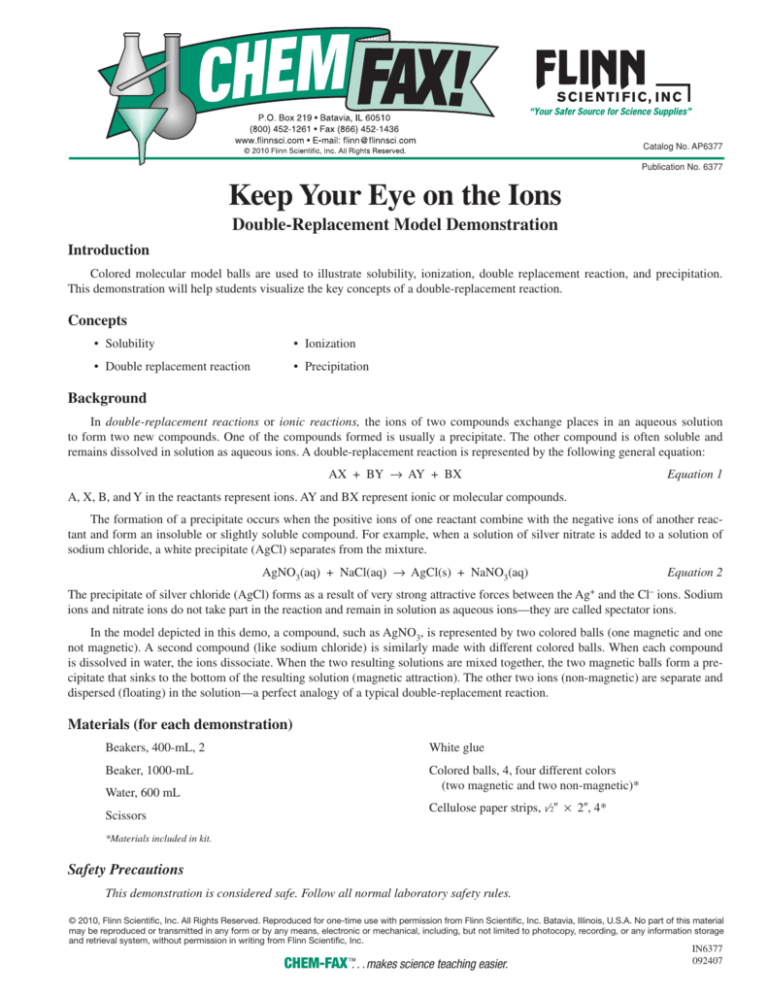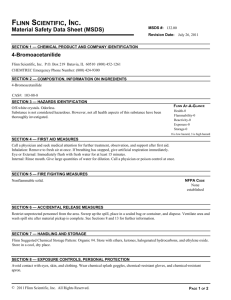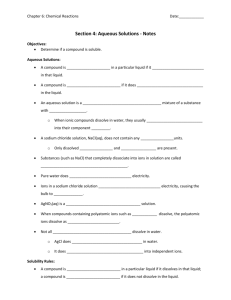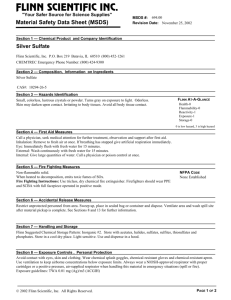
Catalog No. AP6377
Publication No. 6377
Keep Your Eye on the Ions
Double-Replacement Model Demonstration
Introduction
Colored molecular model balls are used to illustrate solubility, ionization, double replacement reaction, and precipitation.
This demonstration will help students visualize the key concepts of a double-replacement reaction.
Concepts
• Solubility
• Ionization
• Double replacement reaction
• Precipitation
Background
In double-replacement reactions or ionic reactions, the ions of two compounds exchange places in an aqueous solution
to form two new compounds. One of the compounds formed is usually a precipitate. The other compound is often soluble and
remains dissolved in solution as aqueous ions. A double-replacement reaction is represented by the following general equation:
AX + BY → AY + BX
Equation 1
A, X, B, and Y in the reactants represent ions. AY and BX represent ionic or molecular compounds.
The formation of a precipitate occurs when the positive ions of one reactant combine with the negative ions of another reactant and form an insoluble or slightly soluble compound. For example, when a solution of silver nitrate is added to a solution of
sodium chloride, a white precipitate (AgCl) separates from the mixture.
AgNO3(aq) + NaCl(aq) → AgCl(s) + NaNO3(aq)
Equation 2
The precipitate of silver chloride (AgCl) forms as a result of very strong attractive forces between the Ag+ and the Cl– ions. Sodium
ions and nitrate ions do not take part in the reaction and remain in solution as aqueous ions—they are called spectator ions.
In the model depicted in this demo, a compound, such as AgNO3, is represented by two colored balls (one magnetic and one
not magnetic). A second compound (like sodium chloride) is similarly made with different colored balls. When each compound
is dissolved in water, the ions dissociate. When the two resulting solutions are mixed together, the two magnetic balls form a precipitate that sinks to the bottom of the resulting solution (magnetic attraction). The other two ions (non-magnetic) are separate and
dispersed (floating) in the solution—a perfect analogy of a typical double-replacement reaction.
Materials (for each demonstration)
Beakers, 400-mL, 2
White glue
Beaker, 1000-mL
Colored balls, 4, four different colors
(two magnetic and two non-magnetic)*
Water, 600 mL
Scissors
Cellulose paper strips, 1⁄2⬙ × 2⬙, 4*
*Materials included in kit.
Safety Precautions
This demonstration is considered safe. Follow all normal laboratory safety rules.
© 2010, Flinn Scientific, Inc. All Rights Reserved. Reproduced for one-time use with permission from Flinn Scientific, Inc. Batavia, Illinois, U.S.A. No part of this material
may be reproduced or transmitted in any form or by any means, electronic or mechanical, including, but not limited to photocopy, recording, or any information storage
and retrieval system, without permission in writing from Flinn Scientific, Inc.
CHEM-FAX姠. . .makes science teaching easier.
IN6377
092407
Preparation
1. Use white glue to glue two strips of cellulose paper
to two colored balls (one magnetic and one nonmagnetic) as shown in Figure 1.
Cellulose Paper
White Glue
Color #2
2. Create another model compound using different
colored balls than those used in step 1. The two
model compounds should contain four balls, all different colors. Allow the glue to dry.
No
Magnet
Magnet
Color #1
White Glue
Cellulose Paper
Figure 1. Model Preparation
Procedure
1. Place 300 mL of water into each of two 400-mL beakers.
2. Show one of the pre-made model compounds to students. Have them note the colors of the balls in the model. Explain that
the glued paper strips represent the bonds holding the atoms together.
3. Place the model compound into one of the beakers of water. The paper will dissolve very quickly and the two balls will
separate. One should sink and one should float, making them separate dramatically. The ions have “dispersed” in the water.
4. Repeat step 3 with the other model compound in the other beaker of water. Again note the colors of the atoms and the ionization depicted.
5. Simultaneously pour the contents of the two “solutions” into the 1000-mL beaker and note the results. The two magnetic
balls should bond and “precipitate” in the bottom of the beaker. The two floating balls will not bond and will float freely in
the solution.
6. Discuss the entire demonstration. Be sure students understand all of the analogies illustrated and can explain the concepts
illustrated by all of the model components. A specific chemical example, like the one given in the Background information,
can be used to illustrate an actual chemical reaction shown in the demonstration.
Disposal
All the glue can be soaked off the balls and they can be reused many times.
Tips
• The kit contains enough materials to perform the demonstration at least seven times for one glue drying cycle.
• Dissolving mole dollars (Flinn AP8678) can be used for making bonds when the paper in this kit is consumed.
• Use your imagination to illustrate other chemical reactions and principles with the materials in this kit.
• Double-sided tape might be used instead of glue to speed up the preparation time.
Connecting to the National Standards
This laboratory activity relates to the following National Science Education Standards (1996):
Unifying Concepts and Processes: Grades K–12
Systems, order, and organization
Evidence, models, and explanation
Content Standards: Grades 5–8
Content Standard B: Physical Science, properties and changes of properties in matter
Content Standards: Grades 9–12
Content Standard B: Physical Science, structure and properties of matter, chemical reactions
© 2010, Flinn Scientific, Inc. All Rights Reserved. Reproduced for one-time use with permission from Flinn Scientific, Inc. Batavia, Illinois, U.S.A. No part of this material
may be reproduced or transmitted in any form or by any means, electronic or mechanical, including, but not limited to photocopy, recording, or any information storage
and retrieval system, without permission in writing from Flinn Scientific, Inc.
–2–
© 2007 Flinn Scientific, Inc. All Rights Reserved.
IN6377
Answers to Worksheet Questions
1. Draw a diagram of each of the following:
a. The “compound”
b. The two beakers, after the compounds had been added
c. After the compounds had been combined
a.
c.
b.
2. Explain the chemical analogy behind what happens when the compounds are first added to water.
When the compounds are added to the water, the two ions of the compound, each represented by a colored ball, separate
from each other. They disperse into the water and the separated ions dissolve.
3. When the compounds are combined, which of the colored ball(s) represents the precipitate?
The two colored balls that “bonded” and sank to the bottom of the beaker represent the precipitate, as they have combined
together and are no longer floating freely in the solution.
4. Write the balanced chemical equation for a double replacement reaction between silver nitrate and sodium chloride.
AgNO3(aq) + NaCl(aq) → AgCl(s) + NaNO3(aq)
Acknowledgment
Special thanks to Ms. Patti Duncan, High Point Regional High School, Sussex, New Jersey for providing this activity.
Materials for Keep Your Eye on the Ions are available from Flinn Scientific, Inc.
Catalog No.
AP6377
AP8678
Description
Keep Your Eye on the Ions—
Double-Replacement Model Demonstration
Melting Mole Dollars
Consult your Flinn Scientific Catalog/Reference Manual for current prices.
© 2010, Flinn Scientific, Inc. All Rights Reserved. Reproduced for one-time use with permission from Flinn Scientific, Inc. Batavia, Illinois, U.S.A. No part of this material
may be reproduced or transmitted in any form or by any means, electronic or mechanical, including, but not limited to photocopy, recording, or any information storage
and retrieval system, without permission in writing from Flinn Scientific, Inc.
–3–
© 2007 Flinn Scientific, Inc. All Rights Reserved.
IN6377
Name: ____________________________________
Demonstration Worksheet
Discussion Questions
1. Draw a diagram of each of the following:
a. The “compound”
b. The two beakers, after the compounds had been added
c. After the compounds had been combined
2. Explain the chemical analogy behind what happens when the compounds are first added to water.
3. When the compounds are combined, which of the colored ball(s) represents the precipitate?
4. Write the balanced chemical equation for a double replacement reaction between silver nitrate and sodium chloride.
© 2010, Flinn Scientific, Inc. All Rights Reserved. Reproduced for one-time use with permission from Flinn Scientific, Inc. Batavia, Illinois, U.S.A. No part of this material
may be reproduced or transmitted in any form or by any means, electronic or mechanical, including, but not limited to photocopy, recording, or any information storage
and retrieval system, without permission in writing from Flinn Scientific, Inc.
IN6377
© 2007 Flinn Scientific, Inc. All Rights Reserved. Reproduction permission is granted only to science teachers who have purchased Keep Your Eye on the Ions, Catalog No. AP6377, from Flinn
Scientific, Inc. No part of this material may be reproduced or transmitted in any form or by any means, electronic or mechanical, including, but not limited to photocopy, recording, or any information
storage and retrieval system, without permission in writing from Flinn Scientific, Inc.








